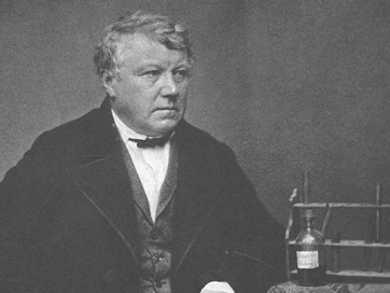Christian Friedrich Schönbein was born in Metzingen, Germany, on October 18, 1799. In 1813, he began an apprenticeship at a chemical factory in Böblingen, Germany. In 1820, he joined Johan Gottfried Dingler’s chemical company in Augsburg, Germany. Dingler had just started the Polytechnisches Journal, and was looking for a capable research chemist to help with the journal’s publication. Schönbein became interested in a more academic career, and from 1821 to 1823, he studied physics, chemistry, and mineralogy at the Universities of Erlangen and Tübingen, both Germany.
After his studies, Schönbein worked as a teacher in Keilhau, Germany, Epsom, England, and Paris, France. In 1828, he joined the University of Basel, Switzerland, acting as a substitute for Professor Peter Merian. Schönbein received an honorary doctorate from the University of Basel in 1829 and was promoted to Full Professor of Chemistry and Physics in 1835. He continued to work in Basel until his death. Christian Friedrich Schönbein died while traveling on August 29, 1868, in Baden-Baden, Germany.
Schönbein’s early research focused on electrochemistry and the passivation of metals. In 1838, he developed one of the earliest fuel cells, composed of two platinum wires submerged in hydrochloric acid, one subjected to a flow of oxygen, the other subjected to a flow of hydrogen. He found a voltage difference between the wires and published this discovery in 1839. The principle of the fuel cell was first met with great enthusiasm, but then forgotten for a long time after the invention of the generator in 1875 had simplified electricity production.
Schönbein discovered ozone in 1839 while working on the electrolysis of water. He noticed a strange smell during the experiments, reminiscent of the odor found in the air following lightning strikes. He named the gas found to be responsible for the odor “ozone”, from the Greek word ὄζειν (ozein) meaning “to smell”. However, he did not accept the idea that ozone was a modified form of oxygen at first, performing experiments meant to falsify this notion until 1849, when he was finally convinced by the results.
In 1845, Schönbein accidentally discovered guncotton while experimenting in his home. He spilled a mixture of nitric and sulphuric acid and mopped it up with cotton cloth, which spontaneously caught fire after drying on the oven door. This was caused by the formation of nitrocellulose (guncotton), an ester of cellulose and nitric acid.
Nitrocellulose had the potential to be a useful explosive in combat because it burned without byproducts and avoided the black smoke of regular gunpowder, which could give a soldier’s position away. Schönbein patented a manufacturing process for guncotton and the patent rights were obtained by John Hall & Son, who manufactured the explosive in Faversham, Kent, UK. However, the manufacturing process was very dangerous and an explosion killed several workers and caused the plant to shut down and guncotton production to cease entirely for years, until safer procedures were developed.
Christian Friedrich Schönbein is the answer to Guess the Chemist (80).
Sources
- Christian Friedrich Schonbein. Part I. Life and character,
R. E. Oesper,
J. Chem. Educ. 1929, 6, 432–440.
https://doi.org/10.1021/ed006p432 - Christian Friedrich Schonbein. Part II. Experimental labors,
R. E. Oesper,
J. Chem. Educ. 1929, 6, 677–685.
https://doi.org/10.1021/ed006p677 - Christian Friedrich Schönbein und die Frühgeschichte der Katalyseforschung (in German),
H.-W. Schütt, C. Reinhardt,
Gesellschaft Deutscher Chemiker, Fachgruppe Geschichte der Chemie, Mitteilungen, 1991, 6, 18–28. - The History of Ozone. The Schönbein Period, 1839–1868,
M. Rubin,
Bull. Hist. Chem. 2001, 26, 40–56
Selected Publications
- On the Odour Accompanying Electricity, and on the Probability of Its Dependence on the Presence of a New Substrate.,
C. F. Schoenbein,
Proc. R. Soc. London 1837, 4, 226–226.
https://doi.org/10.1098/rspl.1837.0114 - Neue Beobachtungen über die Volta’sche Polarisation fester und flüssiger Leiter,
C. F. Schönbein,
Ann. Phys. Chem. 1839, 123, 101–123.
https://doi.org/10.1002/andp.18391230506 - Beobachtungen über chemische Veränderungen, welche Salpetersäure, Weingeist und Aether unter dem gedoppelten Einflusse des Volta’schen Stromes und des Platins erleiden,
C. F. Schönbein,
Ann. Phys. Chem. 1839, 123, 563–583.
https://doi.org/10.1002/andp.18391230803 - Minutes of the Basel Naturalist Society (in German),
C. F. Schönbein,
Ber. Verh. Nat. Ges. Basel 1839, 4, 51. - Notiz über das Ammoniumamalgam,
C. F. Schönbein,
Ann. Phys. Chem. 1840, 125, 210–210.
https://doi.org/10.1002/andp.18401250116 - Ozon ist nicht salpetrichte Säure,
C. F. Schönbein,
Ann. Phys. Chem. 1844, 139, 520–530.
https://doi.org/10.1002/andp.18441391204




